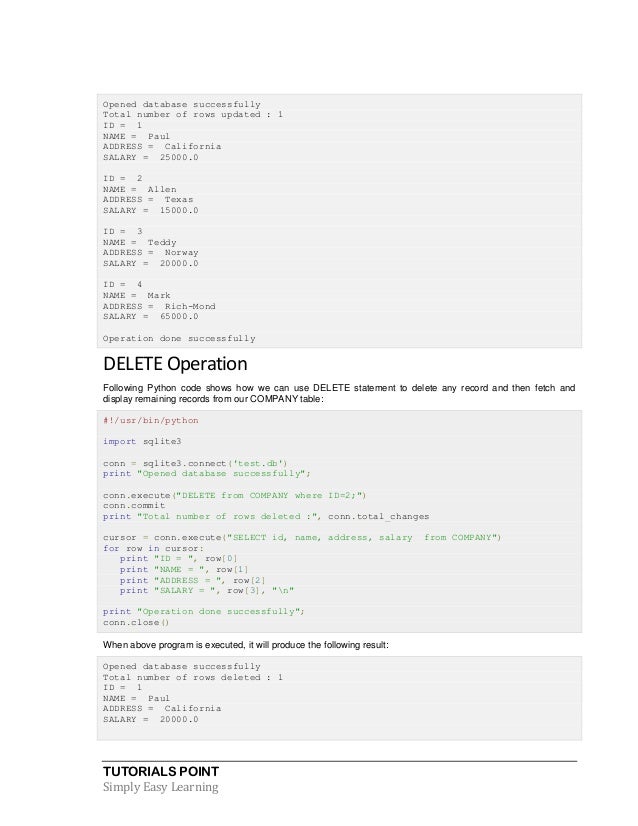

- #Sqlite tutorial how to
- #Sqlite tutorial install
- #Sqlite tutorial software
- #Sqlite tutorial download
To get help, either use man sqlite3 or at the sqlite> prompt, type. Just type the following: $ sqlite3 numismatist.db You should see something very similar to the following: Quarter|30.35|Gift from GrandpaĪll of this can be done from inside SQLite, if, for example, you don’t have an editor, or just want to work directly in SQLite to learn its command-line behavior. Now test that it worked using: $ sqlite3 numismatist.db 'select * from coins' $ cat numismatist.sql | sqlite3 numismatist.db Next, we have to tell SQLite to create our database using the commands in the file we just created. (Or, put it in a make file under new: and let make do the work, for those familiar with make.) Now, anytime you want to start over, or create your own database, you’ll have a trivial example to modify and extend. Now, save this file, then make a copy for yourself, for when you wish to create a another new database, for example: $ cp numismatist.sql skeleton.sql So, break out your favorite text editor and edit numismatist.sql to contain the following (if you don’t have an editor, yet, then keep reading, and you’ll soon be able to finish anyway): /* We are going to begin with a text file representation, and build from there. There are many ways to begin using SQLite. Of course, you are welcome and encouraged to change things, as you work with the examples. The database will be called numismatist.db, and the schema table will be coins. exit.įor the examples we will assume an arbitrary person, in this case, a numismatist (coin-collector). What the sqlite> prompt means is that SQLite is working and ready to do whatever you tell it.

If that’s what you get, then we’re ready to rock! (Substitute appropriate expression….) If not, your Internet Search Engine is your friend. Use ".open FILENAME" to reopen on a persistent database. If you press the, then, you’ll likely see: $ sqlite3Ĭonnected to a transient in-memory database. You’ll likely get a message like: bash: sqlite: command not found

Now, if you succeeded with the install, type the following command: $ sqlite
#Sqlite tutorial download
( synaptic, is another popular installer.)įor those that prefer to build from source-code, you can type in the following script, or download it: $ FILE=sqlite-autoconf-3360000 Then portage will automatically load and compile the most current version.

#Sqlite tutorial install
Which will likely install SQLite version 3. For example, on Debian, one would issue the command: $ apt install sqlite But here’s a few pointers that may help someone new to Linux. This tutorial isn’t about installing programs. But, another good reason, as I stated above, is that SQLite is one of the most widely used database programs in the world–a tool very much worthy of our study. But, SQLite makes it trivial to create, manage, and maintain your own database, all by yourself. Such things often require a team of professionals to setup, manage, and maintain. And that’s what many are called, database servers. Most databases are complex systems, much like a server. When I realized that I actually would have to use a database for an application that I was writing, finding a suitable candidate wasn’t easy. The biggest, and most important, reason is simplicity. The database query language is then able to send queries to extract particular data from the database, or to select all data. Databases are useful for collecting similar bundles of information in one place, a database. SQLite is an Open-Source database program that uses a sub-set of the SQL database descriptor language. $ – requires given linux commands to be executed as a regular non-privileged user # – requires given linux commands to be executed with root privileges either directly as a root user or by use of sudo command Privileged access to your Linux system as root or via the sudo command.
#Sqlite tutorial software
Requirements, Conventions or Software Version Used SQLite Linux Tutorial for Beginners Software Requirements and Conventions Used Software Requirements and Linux Command Line Conventions Category One should consider this a basic part of computer learning. SQLite is used in many, many devices world-wide. So, what is a Database, and what is SQLite?įrom this, you will be able create your own simple databases, and quickly be able to put them to use, when and where needed. SQLite is one of the world’s most widely-used Database programs.
#Sqlite tutorial how to
This SQLite Linux tutorial is intended for beginners who wish to learn how to get started with SQLite database.


 0 kommentar(er)
0 kommentar(er)
